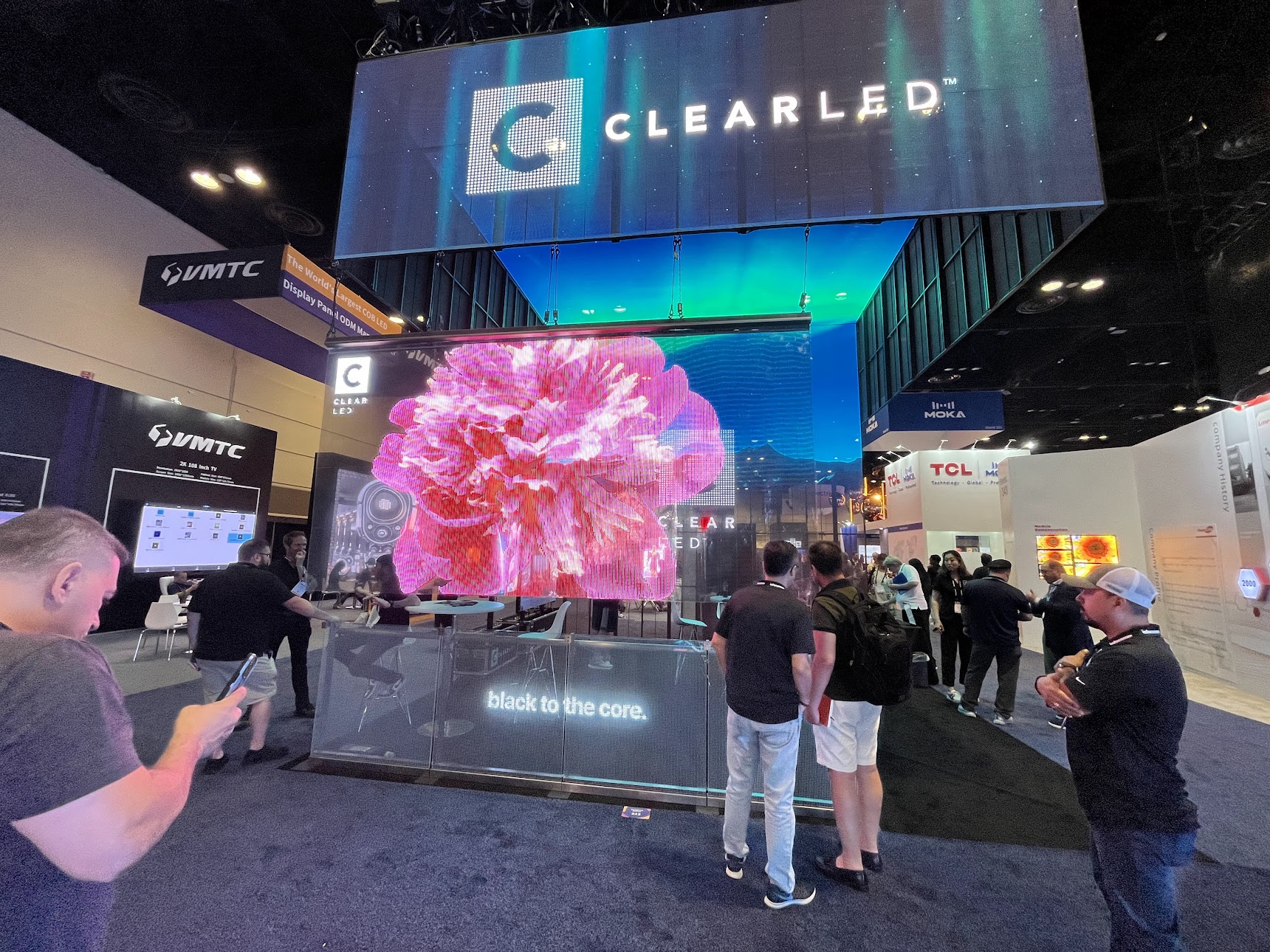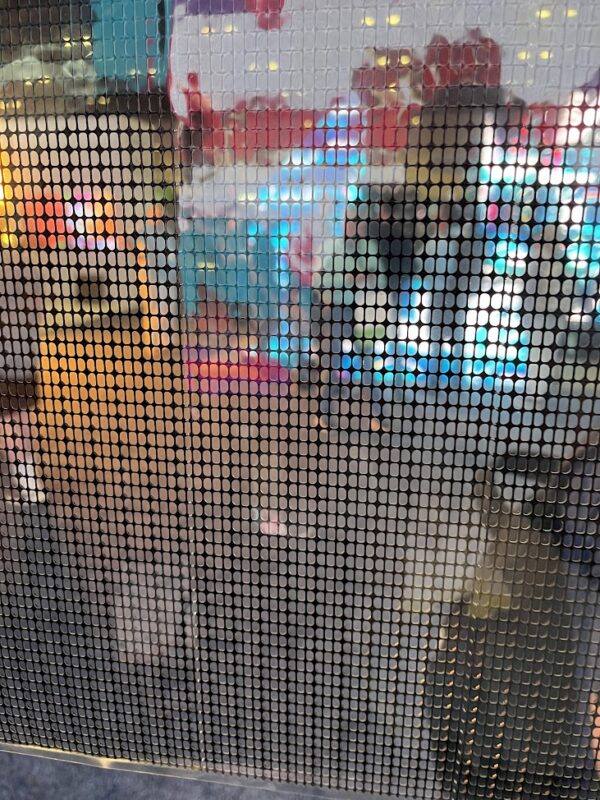
ClearLED Seeing Interest, Demand For Its Micro Mesh LED Displays From Designed Space Community
June 22, 2023 by Dave Haynes
There was a lot of fantastic display technology on show last week at InfoComm in Orlando, but the dozens of LED manufacturers who were there had and have a running challenge of it all looking pretty much the same.
A big microLED video wall looks amazing. But so does a 0.95mm LED wall using Chip On Board. Or a 1.2mm made in some other nuanced way.
So while I certainly pay attention to all that, I tend to find myself looking more at companies operating outside the mainstream – particular when what they offer is not just whiz-bangery like faux holograms or illusions, but have real-world use-cases and the interest of buyers.
Which brought me to ClearLED, which has manufacturing in Shenzhen, China but is run out of North America – with people in Vancouver, BC, LA and Las Vegas. I chatted with founder Jin Fan, whose day to day role now is CMO.
The company is evolving from mesh LED displays, which it still makes and markets, to highly transparent micro-mesh displays that can be applied to window and divider glass or sandwiched inside two sheets of laminated glass. The company’s stand in Orlando had an LED embedded glass balustrade (half height barrier) and a suspended display that I thought looked a bit unfinished, until I found out the rippled look was because the micro mesh screen was still attached to the plastic film layer it ships with. That film peels off when the mesh is adhered to glass.
The real product is the micro mesh, which is the circuit board layer. Each LED light emitter is packaged with its own addressable integrated circuit. The 5mm pitch unit I saw comes in one meter wide by two high sheets, and the mesh can be cut not only horizontally and vertically, but diagonally or even in rounded shapes. I THINK what goes on here is a pitch that’s 5mm horizontally and 10mm vertically, which the close-up below also suggests.

The tightest pitch version right now is 3.5mm.
For displays sandwiches in laminated glass, the circuit board is actually printed on the back layer of the glass and the LED light emitters soldered on top of that. The front layer of the glass is just a protection layer.
I have a sense that being able to convert window and divider/architectural glass into bright, motion displays is going to be a big deal in a lot of built environments. Windows as a display surface has been tried with project, but that has both a brightness challenge and a need to put some sort of opaque film on the glass. Solid displays block the view inside. And more conventional mesh LED displays offer a semi-transparent view through the visual surface, but tend to look like security grid screens from the no-illuminated backside.
These micro-mesh products resolve a lot of that. While they’re not truly invisible – as some manufacturers may cheekily claim – they look that way from a few feet back. They are similar in look to the perforated print vinyl graphics over window glass on buses and trains that get used as rolling billboards. Brightness is 3,000 nits and higher.
I asked Fan who is interested in this material.
“We work with a lot of architects and AV consultants, who are planning future built spaces,” says Fan. “So we get involved in a lot of architectural development, like fixed installations.”
So it’s less about integrators going in and adding to an environment. It’s more about early on planning?
“Yeah, we see more of that,” she says. “I feel like ClearLED has been getting very good at design-build. We are good with taking on a requirement, and then designing and building a system that integrates with new architectural designs. So the final look is very finished, very integrated.”
Fan says she’s also seeing a lot of opportunity in retrofitting and rejuvenating built spaces by adding LED to glass surfaces.
While the future for transparent and semi-transparent LED in retail and other fixed, built spaces may be evolving from rigid mesh displays to micro mesh, foils and LED embedded in clear films, Fan says there’s still a demand for rigid mesh LED walls in other use-cases.
“Some people like the structural factor, for certain situations like exhibitions, trade shows and touring acts. They can easily set it up and tear it down for touring, because they’re so lightweight.”
ClearLED is not, by any means, the only company going down this path. There is NEXNOVO, also from China, Korea’s G-Smatt, Muxwave (China), COBstr (Netherlands) and probably numerous others. The biggest company doing transparent LED is LG, though the tightest pitch for its product is 14mm. It also has gorgeous transparent OLEDs, but you’re looking at big money and something that is best used in lower ambient lighting conditions.
I asked Fan about cost, which she conceded is still high, like double that of more conventional products. That owes a lot to lower manufacturing volumes and specialized custom manufacturing equipment, versus third-party gear used for conventional LED displays. Time, awareness and industry adoption tend to bring costs down gradually.



I sorry, I a bit confused. ClearLed is a great company but this is A) not a big deal break through, B) I can point to at least 6 US companies making almost identical products, some for at least 10 years.
So, no offense, but what’s the big deal? If asked, would be happy to supply the 6 companies names and Phone numbers.
Hi Steve, I am sorry if the post confuses you … but then I am confused by your comments. There is nothing in this post suggesting this is a big breakthrough. I’m just noting how the company and its product line is evolving, as this variation on LED gets better and more commercially viable. If I only wrote about “big deal” breakthroughs in display technology, I’d be writing a handful of posts annually. If you re-read the post you will also notice that I write very clearly that “ClearLED is not, by any means, the only company going down this path” and mention five other companies.
I would be interested in the 6 US companies and their phone numbers! We are looking at this product and Muxwave for potential permanent install.
We are trying to find the highest resolution possible but are also concerned about longevity of brand new products.
From what I can see it seems like the P3.9 pitch of the Muxwave is a differentiator in the market. This article says the ClearLED Micro Mesh comes in P3.5 but the specs they shared with us directly only mentions P8 or P5/P10, so a little confused about that.
I do know TEC Displays (also in China) has a P3.9 adhesive film product now too.